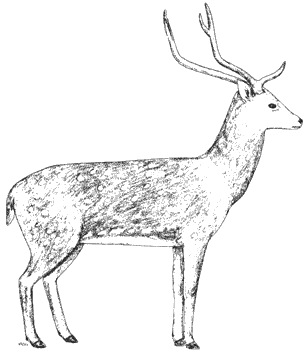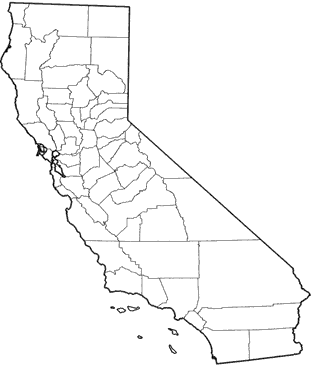
Axis Deer
Distribution, Abundance, and Seasonality
Native to India. Introduced to Point Reyes Peninsula, Marin Co. from the San Francisco Zoo in 1947 and 1948. Now established, with a herd of several hundred. Feed in pastures grazed by livestock, and use the surrounding coastal scrub and closed-cone pine-cypress forests.

Range Map
Specific Habitat Requirements
Feeding: Axis deer graze on green parts of grasses and forbs. Grasses predominate in the diet during the wet season, and forbs predominate during the dry summer (Elliott 1982).
Cover: Use northern coastal scrub and stands of Bishop pine for protection from predators and weather. Fawns born and secluded in these habitats.
Reproduction: Courtship and copulation occur as herds feed and rest in pastures and surrounding northern coastal scrub and Bishop pine stands.
Water: Rarely observed to drink on Point Reyes Peninsula. Sufficient water appears to be available from food (Elliott 1982).
Pattern: Habitat pattern consists of coastal grassland, interspersed with northern coastal scrub and Bishop pine forests. Conversion of scrub and forest into pasture, and moderate grazing by livestock, appear to increase preferred forage.
Species Life History
Activity Patterns: Active yearlong. Active night and day; alternate periods of resting and feeding, in a circadian pattern.
Seasonal Movements / Migration: Non-migratory.
Home Range: Individuals stayed within geographically isolated areas of about 2.6 km? (1 mi?) for several months on Point Reyes Peninsula. Some individuals and herds moved between these areas (Elliott 1973). In India, Schaller (1967) observed home ranges during about half of the yr of approximately 500 ha (1235 ac) for males, and 180 ha (445 ac) for females.
Territory: Apparently not territorial (Nowak and Paradiso 1983).
Reproduction: On Point Reyes Peninsula, polygynous mating occurs throughout the year, with a peak in summer, and a consequent peak in fawning in winter. Does have single fawns, and first give birth during their second yr. Gestation period 8-8.5 mo. Potential annual rate of increase of the doe population was greater thar 20% (Wehausen and Elliott 1982).
Niche: Bobcats and mountain lions are potential predators. Liver flukes (Fasciola hepatica) and lungworms (Dictyocaulus spp.) have been found in a small percentage of axis deer (Brunetti 1976). On Point Reyes Peninsula, axis deer are sympatric with fallow deer, cattle, and the native black-tailed deer, with which they share many food species. At the current densities of axis deer, their good physical condition (Riemann et al. 1979) and high reproductive rate indicate that food resources are not inadequate. However, they are competitors with the cattle, which are fed hay to supplement the range diet. Conversely, livestock grazing increases availability of growing, nutritious plant parts for axis deer. The presence of axis deer apparently does not alter the habitat preferences of the sympatric ungulates, nor do axis deer displace them from their preferred habitats (Elliott 1982). Some authors place the axis deer in the genus Axis (Nowak and Paradiso 1983).
Sources & References
California Department of Fish and Game, 1999.
California's Wildlife, Sacramento, CA.
Written by: H. W. Elliott III, reviewed by: M. White, edited by: G. Ahlborn, M. White
Brunetti, O. A. 1976. Summary of the findings of the deer study on the Point Reyes National Seashore and recommendations for management. Mimeo on file at Pt. Reyes Natl. Seashore, CA. 9pp. Elliott, H. W. III. 1973. A field survey of the exotic axis deer at Pt. Reyes National Seashore. M.S. Thesis, Univ. Calif., Davis. 40pp. Elliott, H. W. III. 1982. Ecological relationships of cattle, axis deer, fallow deer, and black- tailed deer on Point Reyes Peninsula. Ph.D. Diss., Univ. Calif., Davis. 197pp. Nowak, R. M., and J. L. Paradiso. 1983. Walker's mammals of the world. 4th ed. 2 vols. John Hopkins Univ. Press, Baltimore, MD. 1362pp. Riemann, H. P., R. Ruppanner, P. Willeberg, C. E. Franti, H. W. Elliott III, R. A. Fisher, O. A. Brunnetti, J. A. Aho, Jr., J. A. Howarth, and D. E. Behymer. 1979. Serologic profile of exotic deer at Point Reyes National Seashore. J. Amer. Vet. Med. Assoc. 175:911-913. Schaller, G. B. 1967. The deer and the tiger. Univ. Chicago press, Chicago, IL. 370pp. Wehausen, J. D., and H. W. Elliott III. 1982. Range relationships and demography of fallow and axis deer on Point Reyes National Seashore. Calif. Fish and Game. 68:132-145.
California Animal Facts | California's Wildlife